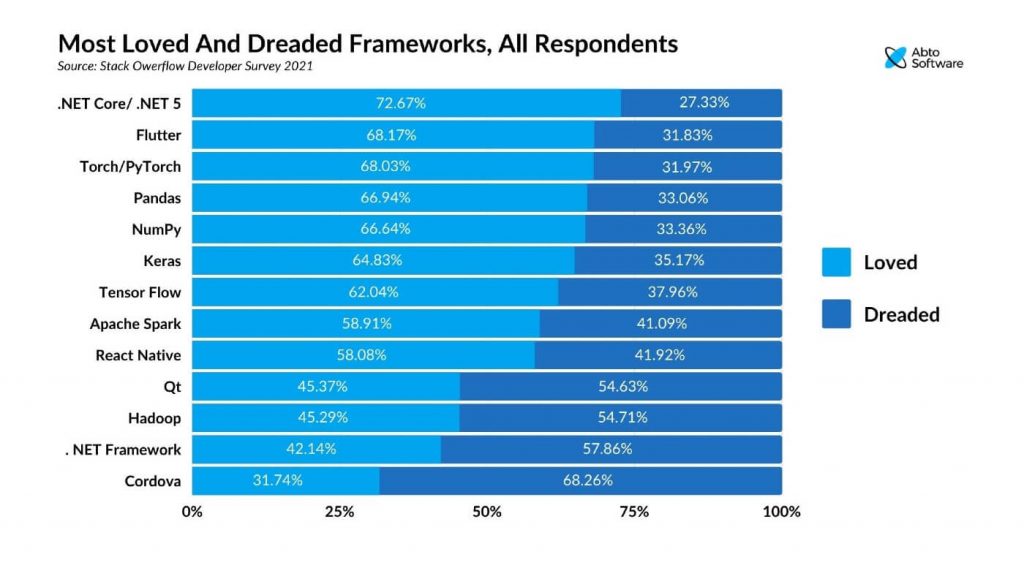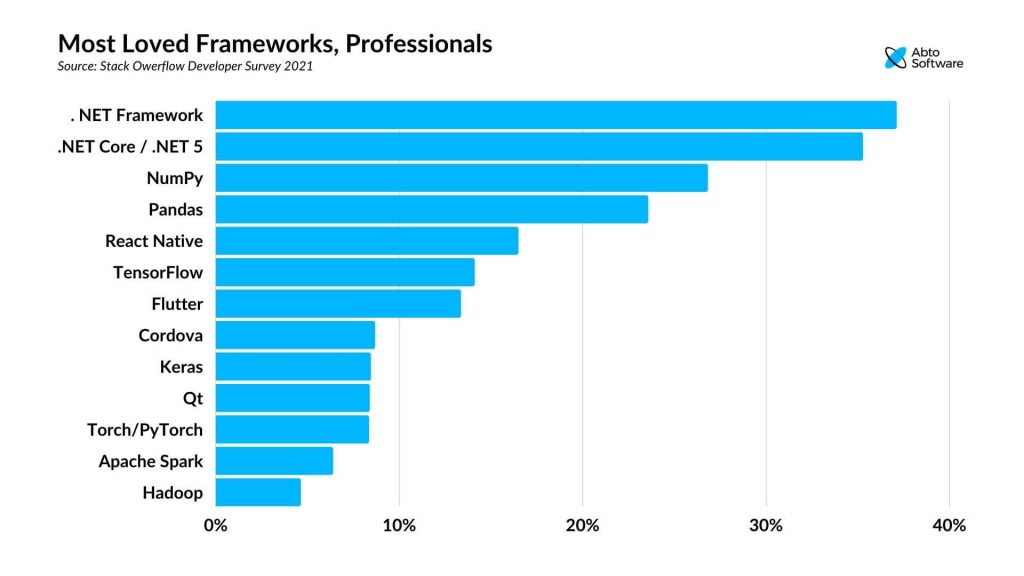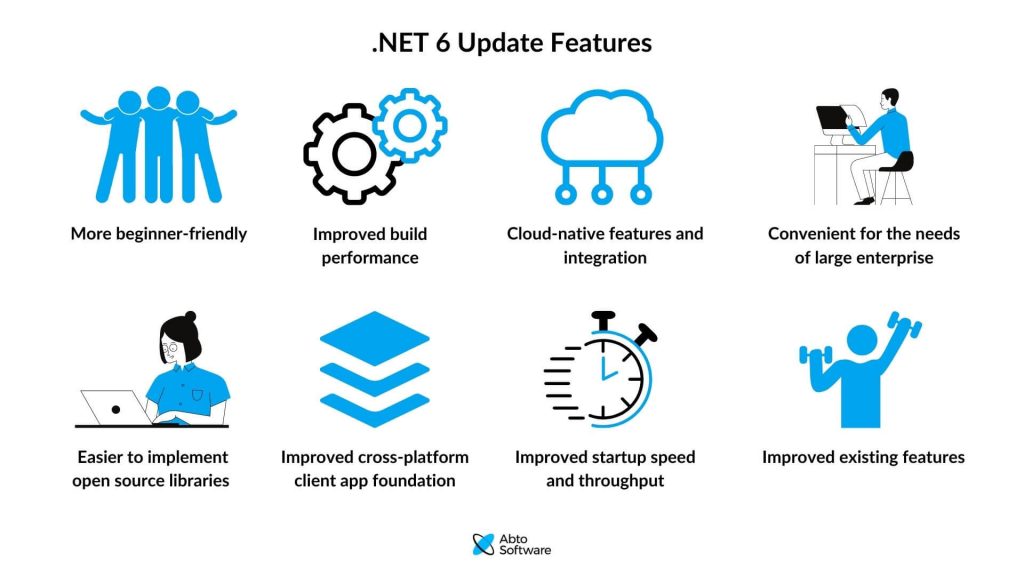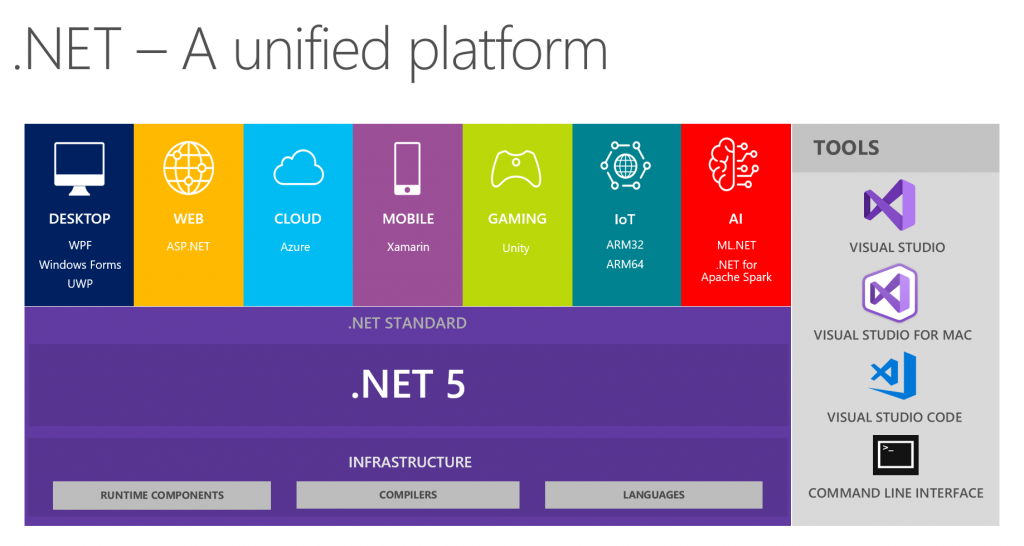Future of .NET Framework and its Recent Updates

What is the future of .NET framework? Is it viable to develop software using the framework in 2021 and beyond? If so, how long will it last, staying relevant and compatible with the ever-growing performance demands?
To find all the answers we need, let’s analyze the current state of Microsoft’s .NET software development ecosystem, its plans, and the framework’s potential.
Microsoft’s .NET Plans
Any development platform is as relevant as the minds behind it are interested in its development. So, let’s take a look at the future of .NET framework through the lens of Microsoft’s plans.
It’s been a year since Microsoft presented .NET 5. It’s a solid overhaul of the framework as an open-source cross-platform development powerhouse. It was a significant move on the behalf of the company, but it didn’t stop there.
Microsoft promised to adopt a crazy rate of .NET updates, intending to roll out a new version of the framework each November. Considering the size and capabilities of .NET, it’s a considerable commitment and investment for the tech behemoth. It means two things:
- Microsoft will do everything it can to keep the platform up to date with the most urgent demands of the development community.
- Microsoft believes .NET has all the potential to be the future of software development, regardless of the curveballs this future can throw.
Does the reality reflect their ambitions?
The Present and Future of .NET Framework
The future of the .NET framework is being created right now: уach update of the framework, the development community’s reactions to it, and the general perception of the platform are the basis and motivation for its further growth.
So,
What’s the Present of the .NET Framework?
In a 2021 survey of 80,000 developers conducted by StackOverflow,
- 72% of respondents rated .NET 5 and its predecessor .NET Core as the most loved development platform.

- 37% of professional developers rated .NET Framework as their most loved framework. .NET 5 is lagging slightly behind.

Regardless of how you look at it, those are impressive numbers for two reasons:
- Professional developers are really demanding to nitpicky about their tools;
- .NET 5 is a fresh new platform, which already sees widespread use.
The first is the result of the .NET Framework:
- Ease of use;
- High-security standards;
- A broad spectrum of different tools available within the .NET ecosystem;
- High Microsoft standards and their continuous support and development of the platform;
- An active community;
- The popularity of Windows OS.
Besides, the .NET framework has been used by thousands of companies for almost two decades now. So, no wonder that when .NET 5 arrived, it found immediate popularity. As a natural evolution of the framework, it took .NET’s capacities and wrapped them into the open-source and cross-platform capabilities on top of adding various new features.


.NET Software Development
Microsoft Gold Partner with 14 years of experience.
As you see, .NET 5 was already a solid, well-received foundation for further development.
Recently, .NET 6 has released and brought a bunch of new updates, which are aimed at:

- Making .NET more beginner-friendly “with clear docs, simpler code models with fewer files and concepts to learn, and intuitive paths to deploying artefacts to test and production environments.” (Growing the next generation of developers is always a vital priority, and it’s great to see Microsoft working on it.)
- Improving an existing cross-platform client app foundation through the tools such as Blazor and Xamarin.
- Adding cloud-native features and integration with the cloud-native and container ecosystems.
- Making .NET more suitable to the needs of large enterprise and government customers.
- Making it easier to implement into the development process libraries from community open source projects. (Solid community libraries can be a real life-saver for developers. They can cut development time and save a lot of headaches. So, we’re particularly happy to see such an update.)
- Improving build performance, hot restart, and hot reload.
- Improving startup speed and throughput.
- Improving existing features to satisfy the development community.
- Implementing cross-platform Linux testing
- Adding Web Live Preview function
What’s the Future of the .NET Framework?
So, what is beyond .NET 6? What can we expect further into the future of the .NET framework?
First of all, the main benefit of .NET 5 is that it was the first major step on the path of the framework’s unification — creating a single development powerhouse ecosystem that combines desktop, web, cloud, mobile, gaming, IoT, and AI creation tools.

Any kind of unification of different development tools into a single overarching system is a good thing. A single point of access to the vast array of different programming tools makes the development process smoother, quicker, and safer. As a result, it also makes the development cheaper for the client.
Therefore, you can certainly expect the further strengthening of this unification with each passing year.
Furthermore, let’s take a look at Themes of .NET — a resource that collects the most urgent and discussed issues and trends within the .NET development community. Accounting for it, we can anticipate the further vectors of .NET evolution, such as:
- Making the learning curve of .NET even friendlier to beginners. The more people the framework can hook, the more active community, more libraries, and potential .NET will have.
- Strengthening open-source capabilities. Making community-centred development possible is a complex but important process as the future of development is open source. So, we can expect Microsoft to continue improving the framework’s open-source capacity with each .NET iteration.
- Improving cross-platform UI-building features in Blazor, ASP.NET. If you want your framework to be the relevant future of software development, you need to ensure not only smooth logic programming but also polished UI creation regardless of the targeted platforms.
- Improving on MAUI. With MAUI replacing Xamarin.Forms, we can expect even more powerful cross-platform functionality from the framework.
- Boosting project build, code compilations, and overall performance speeds. This goal includes but is not limited to hot-reloading across ASP.NET and ahead-of-time compilation for Blazor.
- Improving .NET’s machine learning and artificial intelligence capacities. There’s no point in discussing the importance of ML for the future of software development. So, we can expect a further improvement of .NET’s ML library to make the integration of machine learning algorithms into projects easier and more powerful.
- Even more attention and improvements to C#. Microsoft sidelined Visual Basic quite some time ago, focusing their most exciting programming language updates on C#. It’s difficult to say how quickly Visual Basic will fade into complete obscurity, but we’re certain that C# will continue blooming.
Is it worth developing software on .NET in 2022 and beyond?
The short answer is: yes, definitely. The framework has all the capacities required to deliver reliable and secure software either on the level of enterprises or small businesses. And seeing the current developments of the framework, we believe .NET’s future is stable and bright.
Also, when imagining a software development tool of the future, what do you picture?
The vision that Microsoft is selling us with its .NET 6 and beyond — a unified tool that can handle all the spectrum of software development from the web to AI, IoT, and gaming — aligns with our vision for a solid, convenient, and cost-efficient framework.
We’ll be watching the evolution of the .NET ecosystem with great interest, eager to use what it has to offer when building software for our clients.
Have a project in mind? Let’s discuss.
FAQ
1. How to check the .NET framework version?
To check the .NET Framework version:
- Open Windows Control Panel
- Go to Programs and Features (or Programs)
- Find “Microsoft .NET Framework” in the list of installed programs
- Check the framework’s version in the Version column to the right of the window.
2. How to change the .NET framework version in visual studio?
To change the .NET framework version:
- Go to the Solution Explorer and select the project.
- Right-click on the project.
- Select Application from the left pane menu.
- Find the Target Framework option and select the required .NET version.
3. What are the languages used in the .NET framework?
.NET framework uses the following programming languages:
- C# — a simple, object-oriented, and type-safe programming language.
- F# — a programming language for writing succinct, robust, and performant code.
- Visual Basic — a type-safe programming language.


